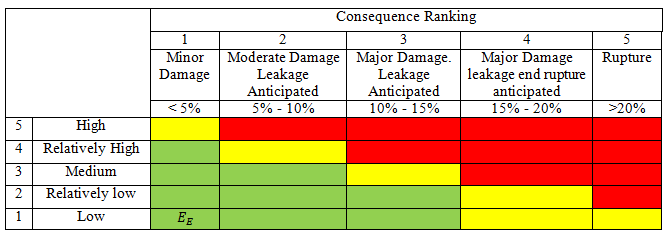RISK ANALYSIS OF DROPPED ANCHOR IMPACT ON SUBSEA PIPELINES IN NATUNA
Main Article Content
Abstract
Energy is a fundamental element in economic and social development, with oil and natural gas remaining the primary energy sources in Indonesia. To support the distribution of hydrocarbons from production facilities to onshore locations, subsea pipelines serve as vital infrastructure in the upstream oil and gas industry. However, subsea pipelines face various external risks, including dropped ship anchors, which can cause significant damage both technically and environmentally. This study aims to analyze the risk level of dropped anchors on subsea pipelines in Natuna. The methodology involves data collection related to pipeline characteristics, vessel traffic, and anchor types. Consequence analysis is conducted by calculating pipeline dent levels due to anchor kinetic energy based on the DNV-RP-F107 guideline. The results show that the anchor impact energy on the pipeline is approximately 3,94 kJ, placing the pipeline consequence level in the <5% dent/diameter category. Risk assessment using a risk matrix indicates that the risk level remains within the ALARP (As Low As Reasonably Practicable) threshold, meaning the risk is acceptable with reasonable mitigation measures. The findings suggest that although dropped anchors can cause pipeline deformation, the resulting damage remains within safe limits. However, to further reduce potential risks, additional mitigation measures are required, such as vessel traffic monitoring, designated anchor-free zones, and enhancing pipeline resilience against external impacts.
Downloads
Article Details

This work is licensed under a Creative Commons Attribution 4.0 International License.
Allow anyone to modify, improve, and make derivative works, even for commercial purposes, as long as they credit to you for the original work.
References
[1] A. Rahman, R. Richards, P. Dargusch, and D. Wadley, "Pathways to reduce Indonesia’s dependence on oil and achieve longer-term decarbonization," Renewable Energy, vol. 202, pp. 1305-1323, 2023/01/01/ 2023, doi: https://doi.org/10.1016/j.renene.2022.11.051.
[2] M. Randolph and S. Gourvenec, Offshore Geotechnical Engineering, 1st ed. ed. CRC Press, 2011.
[3] F. Hou, Y. Chen, Y. Yan, R. Liu, Y. Liu, and R. Zhong, "Structural response and damage assessment method for subsea pipe-in-pipe subjected to anchor impact," Marine Structures, vol. 99, p. 103714, 2025.
[4] F. Jiang and S. Dong, "Two-level quantitative risk analysis of submarine pipelines from dropped objects considering pipe–soil interaction," Ocean Engineering, vol. 257, p. 111620, 2022.
[5] R. Selker, P. Liu, D. Karras, R. Bijker, and O. Aktan, "Impact of dropped objects and anchor dragging on pipeline integrity," in ISOPE International Ocean and Polar Engineering Conference, 2018: ISOPE, pp. ISOPE-I-18-537.
[6] A. Mustafina, "Anchor damage assessment of subsea pipelines-optimization of design methodology," University of Stavanger, Norway, 2015.
[7] S. A. Murtopo and L. Chimayati, "Kajian Pengelolaan Kecelakaan Kerja Industri Minyak dan Gas Lepas Pantai (Offshore) dengan Metode Failure Mode Effect and Analysis (FMEA)," UEEJ-Unbara Environmental Engineering Journal2, vol. 3, no. 02, 2023.
[8] A. D. Endijanto, "Analisis Risiko Kecelakaan Kerja pada Progressive Pigging Pipa Bawah Laut 12" MOL LCOM-NGLB," Institut Teknologi Sepuluh Nopember, 2023.
[9] V. A. Tanujaya, R. L. Tawekal, and J. R. Tawekal, "DESAIN DAN ANALISIS RISIKO PIPA BAWAH LAUT DI PERAIRAN LAUT MADURA BERDASARKAN STANDAR DNVGL RP-F107."
[10] A. P. D. Utomo, D. V. Siregar, E. F. Manurung, J. H. M. Sitinjak, and W. Hidayat, "Analisis Risiko dan Mitigasi Pencemaran Laut Akibat Kecelakaan Kapal di Alur Pelayaran," Jurnal Ilmiah Manajemen, Ekonomi, & Akuntansi (MEA), vol. 8, no. 2, pp. 1855-1873, 2024.
[11] D. R. Aldara, R. S. DewI, and A. M. Mulananda, "Analisa Kerusakan Pipa Bawah Laut Akibat dari Kejatuhan Jangkar," Techno Bahari, vol. 9, no. 2, 2022.

